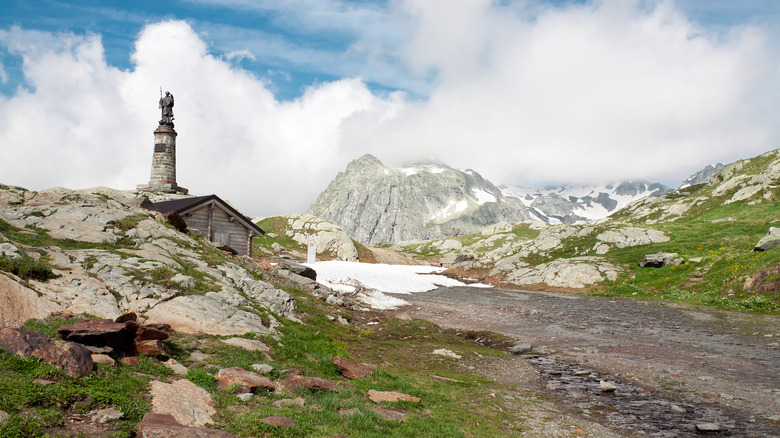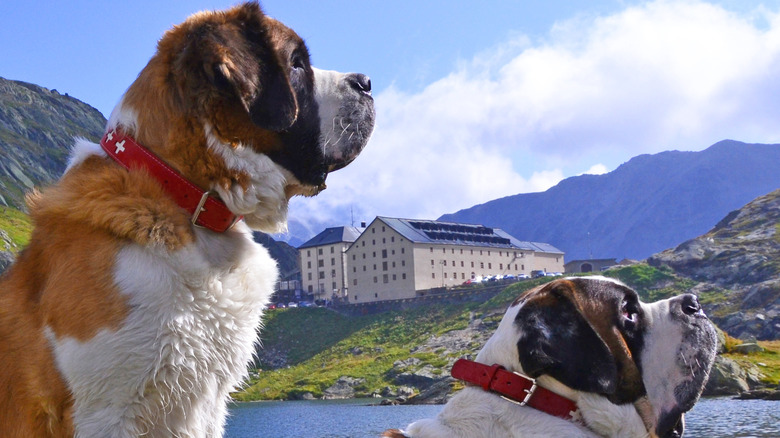Imagine yourself on a road in the Alps as it winds through the mountains. You will pass by a beautiful lake and an 11th-century hospice founded by Augustine monks, surrounded by snow-capped peaks, on your journey from Martigny-Ville, Switzerland, to Aosta, Italy. (“Hospice” in this context means a place of rest for travelers.) You’d be traveling the road that many before you traversed in challenging conditions, like Napoleon Bonaparte and his troops in 1800. This is the Great St. Bernard Pass, and yes, St. Bernard dogs are a part of this story. On a side note, if you’re intrigued by Bonaparte, carve time to visit this underrated island for a crowd-free Italian vacation.
The Great St. Bernard Pass is a 50-mile stretch that takes less than an hour and a half, depending on conditions. This is the Alps we’re talking about, so the winter will make things more challenging. That doesn’t stop people from going and snowshoeing up to the hospice, which you can stay at during certain parts of the year. Let’s take a drive across the Great St. Bernard Pass and see what you can do in the area and the fascinating history you can learn at the Great St. Bernard Hospice.
What to know about the Great St. Bernard Pass

The Great St. Bernard Pass is one of the highest in the area, at 8,100 feet above sea level. People have been crossing here since the Roman Empire. You can still see remnants of a Roman road right at the summit. There was even a temple to Jupiter Poeninus here, and we’ll tell you where to see the Jupiter statue in a moment. A group of Augustine monks founded a monastery and hospice that helped travelers for centuries, and it’s still around despite challenges.
The monks began to breed St. Bernard dogs here in the 17th century to protect and help with rescues. A famous dog named Barry is said to have saved over 40 people, making him the “very goodest doggo.” St. Bernards continued to be bred here until 2004. If you visit between July and August, book a hike with St. Bernards. This hike is physically demanding, so ensure you’re up for the challenge.
Carry your passport if you enter Italy from Switzerland or vice versa. Bring some food and water for your car, just in case, especially in the winter. Do note that there can be tolls. If you cross in the winter, there is a 3.5-mile-long tunnel built in 1964 to make it easier. The stunning mountain peaks of the Alps, the lake, and the scenery around you are what you may be going for, but if you love history, you should stop and visit the hospice.
The Great St. Bernard Hospice

The hospice, which you can see behind the dogs above, is still an active monastery. If you don’t want to drive, you can take the strenuous 4-mile hike (you’ll need snowshoes in the winter). Food is served at communal tables with veggie soup, Bagnes cheese, honeyed tea, brown bread, and red Dôle wine from the nearby Valais region. You can stay in either a private room or a dorm from June through mid-October, with different packages like bed and breakfast or half board with dinner and a bed and breakfast. Consult the website to book, and do so early if you want a private room. Sleeping bags are required in the dorms, and you can purchase one there if you need it.
It’s not just food and a bed, though. The hospice allows you to view some of the sacred objects they have, plus the statue of Jupiter that was excavated in the 19th century. There is a museum (open mid-June through October) in the hotel opposite the hospice with information on flora and fauna, some Gallic coins found there, Roman money, weapons from the Bronze Age, and old maps of the area. There is also an 800-year-old crypt full of travelers who died on the way across and a registry of famous people who passed this way, like Charlemagne, Alexandré Dumas, and Napoleon with his troops.

